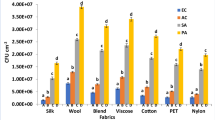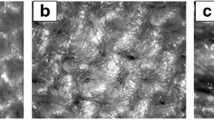Abstract
In sectors like healthcare and hospitality, it has been realized that fabrics play a pivotal role in transfer of nosocomial infections. However, there is a major gap in drawing correlation between different fibre types and their interaction with microorganisms. Such information is important to formulate guidelines for textile materials for use in these sectors. In the current study, the adherence of four important bacteria, Staphylococcus aureus, Acinetobacter calcoaceticus, Escherichia coli, and Pseudomonas aeruginosa was studied on six different fibre types namely polyester, wool, polypropylene, viscose, silk and cotton. Among these fibres, viscose showed maximum adherence while silk fibres showed the least attachment of bacterial strains. Bacterial adhesion was correlated with the surface characteristics (surface charge, hydrophobicity etc.) of bacteria, and nanoroughness of fibres. Adhesion of these bacteria was tested on five hydrocarbons of different hydrophobicities. E. coli, the weakest biofilm producer, and with the highest surface energy and lowest hydrophobicity amongst the bacteria compared in the study, had the lowest load on all fibres. Scanning electron microscopy revealed non-uniform binding of gram-negative and gram-positive bacteria. Nanoroughness of fibres favored bacterial adhesion. The study showed correlation between surface properties and adherence of bacteria on fibres, with the results being of direct significance to medical and hospitality sectors.


Similar content being viewed by others
References
Bajpai V, Dey A, Ghosh S, Bajpai S, Jha MK (2011) Quantification of bacterial adherence on different textile fabrics. Int Biodeterior Biodegrad 65:1169–1174. https://doi.org/10.1016/j.ibiod.2011.04.012
Banu A, Anand M, Nagi N (2012) White coats as a vehicle for bacterial dissemination. J Clinic Diagnos Res 6:1381–1384. https://doi.org/10.7860/jcdr/2012/4286.2364
Gupta P, Bairagi N, Priyadarshini R, Singh A, Chauhan D, Gupta D (2016) Bacterial contamination of nurses’ white coats made from polyester and blend fabric. J Hos Infect 94:92–94
Sailo CV, Pandey P, Mukherjee S, Zami Z, Lalremruata R, Nemi L, Senthil Kumar N (2019) Pathogenic microbes contaminating mobile phones in hospital environment in Northeast India: incidence and antibiotic resistance. Trop Med Health 47:59
Subbalaxmi MVS, Lakshmi V, Lavanya V (2010) Antibiotic resistance—experience in a tertiary care hospital in South India. J Assoc Phys India 58:Suppl.18-S22
Oh JK, Yegin Y, Yang F, Zhang M, Li J, Huang S, Verkhoturov SV, Schweikert EA, Perez-Lewis K, Scholar EA, Taylor TM, Castillo A, Cisneros-Zevallos A, Min Y, Akbulut M (2018) The influence of surface chemistry on the kinetics and thermodynamics of bacterial adhesion. Sci Rep 8:17247. https://doi.org/10.1038/s41598-018-35343-1
Lebeaux D, Ghigo JM, Beloin C (2014) Biofilm-related infections: bridging the gap between clinical management and fundamental aspects of recalcitrance toward antibiotics. Microbiol Mol Biol Rev 78:510–543. https://doi.org/10.1128/mmbr.00013-14
Grancarić AM, Ristić N, Tarbuk A, Ristić I (2013) Electrokinetic phenomena of cationised cotton and its dyeability with reactive dyes. Fibres Text East Eur 21:106–110
Wu J, Liu H, Wang P, Zhang D, Sun Y, Li E (2017) Oxygen reduction reaction affected by sulfate-reducing bacteria: different roles of bacterial cells and metabolites. Ind J Microbiol 57:344–350. https://doi.org/10.1007/s12088-014-0488-2
Goel A, Halami PM, Tamang J (2020) Genome analysis of Lactobacillus plantarum isolated from some Indian fermented foods for bacteriocin production and probiotic marker genes. Front Microbiol 11:40. https://doi.org/10.3389/fmicb.2020.00040
Dixit D, Soppina V, Ghoroi C (2019) A non-electric and affordable surface engineered particle (SEP) based point-of-use (POU) water disinfection system. Sci Rep 9:18245
Stepanović S, Vuković D, Hola V, Bonaventura GD, Djukić S, Ćirković I, Ruzicka F (2007) Quantification of biofilm in microtiter plates: overview of testing conditions and practical recommendations for assessment of biofilm production by Staphylococci. Apmis 115:891–899. https://doi.org/10.1111/j.1600-0463.2007.apm_630.x
Rodrigues LB, dos Santos LR, Tagliari VZ, Rizzo NN, Trenhago G, de Oilveira AP, Goetz F, do Nascimento VP (2010) Quantification of biofilm production on polystyrene by Listeria, Escherichia coli and Staphylococcus aureus isolated from a poultry slaughterhouse. Braz J Microbiol 41:1082–1085
Little TM, Hills FC (1978) Agricultural Experimentation. Wiley, Hoboken
Kelleher SM, Habimana O, Lawler J, O’reilly B, Daniels S, Casey E, Cowley A (2016) Cicada wing surface topography: An investigation into the bactericidal properties of nanostructural features. ACS Appl Mater Interfaces 8:14966–14974. https://doi.org/10.1021/acsami.5b08309
Abrigo M, Kingshott P, McArthur SL (2015) Electrospun polystyrene fiber diameter influencing bacterial attachment, proliferation, and growth. ACS Appl Mater Interfaces 7:7644–7652. https://doi.org/10.1021/acsami.5b00453
Oh JK, Yegin Y, Yang F, Zhang M, Li J, Huang S, Taylor TM (2018) The influence of surface chemistry on the kinetics and thermodynamics of bacterial adhesion. Sci Rep 8:1–13. https://doi.org/10.1038/s41598-018-35343-1
Ploux L, Ponche A, Anselme K. Bacteria/material interfaces: role of the material and cell wall properties (2010) J Adhes Sci Technol 24:2165 – 201.https://doi.org/10.1163/016942410X511079
Yuan Y, Hays MP, Hardwidge PR, Kim J (2017) Surface characteristics influencing bacterial adhesion to polymeric substrates. RSC Adv 7:14254–14261. https://doi.org/10.1039/C7RA01571B
Bagherifard S, Hickey DJ, de Luca AC, Malheiro VN, Markaki AE, Guagliano M, Webster TJ (2015) The influence of nanostructured features on bacterial adhesion and bone cell functions on severely shot peened 316L stainless steel. Biomaterials 73:185–197. https://doi.org/10.1016/j.biomaterials.2015.09.019
Krasowska A, Sigler K (2014) How microorganisms use hydrophobicity and what does this mean for human needs? Front Cell Infect Microbiol 4:1–7. https://doi.org/10.3389/fcimb.2014.00112
Takashima M, Shirai F, Sageshima M, Ikeda N, Okamoto Y, Dohi Y (2004) Distinctive bacteria-binding property of cloth material. Am J Infect Cont 32:27–30. https://doi.org/10.1016/j.ajic.2003.05.003
Berne C, Ducret A, Hardy GG, Brun YV (2015) Adhesins involved in attachment to abiotic surfaces by Gram-negative bacteria. Microbial Biofilms, 163–199. https://doi.org/10.1128/9781555817466.ch9
Gupta K, Singh SP, Manhar AK, Saikia D, Namsa ND, Konwar BK, Mandal M (2019) Inhibition of Staphylococcus aureus and Pseudomonas aeruginosa biofilm and virulence by active fraction of Syzygium cumini (L.) skeels leaf extract: in-vitro and in silico studies. Ind J Microbiol 59:13–21. https://doi.org/10.1007/s12088-018-0770-9
Gui Z, Wang H, Ding T, Zhu W, Zhuang X, Chu W (2014) Azithromycin reduces the production of α-hemolysin and biofilm formation in Staphylococcus aureus. Ind J Microbiol 54:114–117
Martí S, Rodríguez-Baño J, Catel-Ferreira M, Jouenne T, Vila J, Seifert H, Dé E (2011) Biofilm formation at the solid-liquid and air-liquid interfaces by Acinetobacter species. BMC Res Notes 4:1–5. https://doi.org/10.1186/1756-0500-4-5
Sharma G, Sharma S, Sharma P, Chandola D, Dang S, Gupta S, Gabrani R (2016) Escherichia coli biofilm: development and therapeutic strategies. J Appl Microbiol 121:309–319. doi:https://doi.org/10.1111/jam.13078
Chagnot C, Zorgani MA, Astruc T, Desvaux M (2013) Proteinaceous determinants of surface colonization in bacteria: bacterial adhesion and biofilm formation from a protein secretion perspective. Front Microbiol 4:1–26. https://doi.org/10.3389/fmicb.2013.00303
Ploux L, Ponche A, Anselme K (2010) Bacteria/material interfaces: role of the material and cell wall properties. J Adhesi Sci Technol 24:2165–2201. https://doi.org/10.1163/016942410X511079
Schmidt-Emrich S, Stiefel P, Rupper P, Katzenmeier H, Amberg C, Maniura-Weber K, Ren Q (2016) Rapid assay to assess bacterial adhesion on textiles. Materials 9:1–13. https://doi.org/10.3390/ma9040249
Azam MT, Khan AS, Muzzafar D, Faryal R, Siddiqi SA, Ahmad R, Rehman IU (2015) Structural, surface, in vitro bacterial adhesion and biofilm formation analysis of three dental restorative composites. Materials 8:3221–3237. https://doi.org/10.3390/ma8063221
Kurmoo Y, Hook AL, Harvey D, Dubern J-F, Williams P, Morgan SP, Korposh S, Alexander MR (2020) Real time monitoring of biofilm formation on coated medical devices for the reduction and interception of bacterial infections. Biomater Sci 8:1464–1477
Pericolini E, Colombari B, Ferretti G, Iseppi R, Ardizzoni A, Girardis M, Sala A, Peppoloni S, Blasi E (2018) Real-time monitoring of Pseudomonas aeruginosa biofilm formation on endotracheal tubes in vitro. BMC Microbiol 18:84. https://doi.org/10.1186/s12866-018-1224-6
Saxena P, Joshi Y, Rawat K, Bisht R (2019) Biofilms: Architecture, resistance, quorum sensing and control mechanisms. Ind J Microbiol 59:3–12. https://doi.org/10.1007/s12088-018-0757-6
Acknowledgements
This work was supported by FIRP Scheme (MI01681G) and Grand Challenge Scheme (MI1798G) of IIT Delhi. SV acknowledges fellowship received from DST-INSPIRE towards her doctoral work.
Author information
Authors and Affiliations
Corresponding author
Ethics declarations
Conflict of interest
The authors declare no conflict of interest.
Additional information
Publisher's Note
Springer Nature remains neutral with regard to jurisdictional claims in published maps and institutional affiliations.
Electronic Supplementary Material
Below is the link to the electronic supplementary material.
Rights and permissions
About this article
Cite this article
Varshney, S., Sain, A., Gupta, D. et al. Factors Affecting Bacterial Adhesion on Selected Textile Fibres. Indian J Microbiol 61, 31–37 (2021). https://doi.org/10.1007/s12088-020-00903-5
Received:
Accepted:
Published:
Issue Date:
DOI: https://doi.org/10.1007/s12088-020-00903-5




